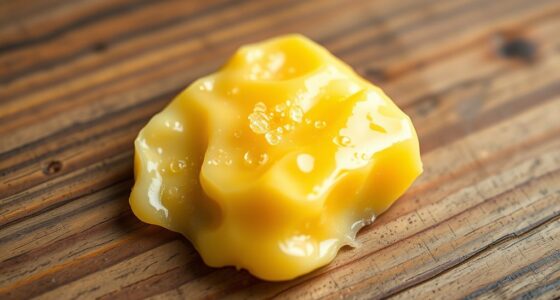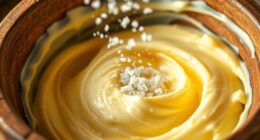Sound can indeed influence how you perceive butter’s flavor. Research shows that high-pitched sounds may enhance creaminess, while deeper tones might emphasize richness. Your brain combines auditory cues with taste, creating multisensory experiences. Although some skepticism exists about the strength of these effects, experiments suggest sound can subtly shift flavor perception. If you’re curious about how certain sounds might transform your tasting experience, exploring further reveals fascinating insights into sensory synergy.
Key Takeaways
- Certain high-pitched sounds can increase the perception of creaminess and richness in butter.
- Auditory cues influence taste perception through multisensory integration and sensory synergy.
- Scientific studies demonstrate sound can actively modulate butter flavor perception.
- The effects are based on crossmodal interactions, where sound alters neural pathways related to taste.
- Skepticism exists, and more research is needed to confirm the direct impact of sound on butter flavor perception.
The Science Behind Sonic Seasoning
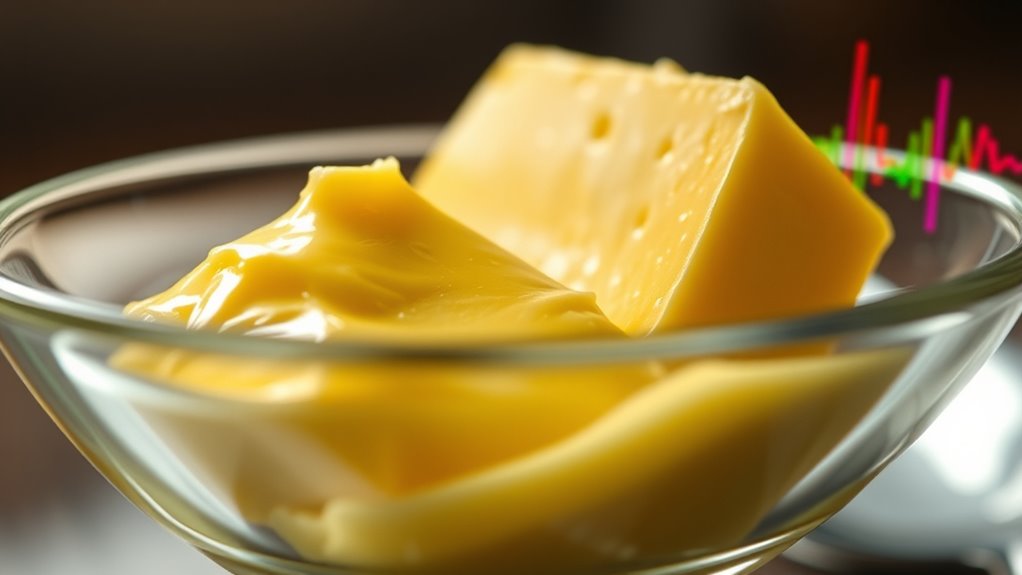
Sonic seasoning is rooted in the idea that sound can influence how we perceive taste, and recent research shows that certain frequencies and tones can enhance or alter flavor experiences. This phenomenon relies on sensory synergy, where different senses work together to shape your perception. Through crossmodal effects, sounds can modify how you interpret flavors, blending auditory cues with taste sensations. For example, specific pitches or rhythms may amplify sweetness or bitterness, creating a more immersive experience. Scientists have uncovered how these interactions occur, revealing that the brain integrates sensory information from multiple modalities. Additionally, the mechanisms behind sensory integration explain how auditory stimuli can directly influence taste perception. By understanding these crossmodal effects, researchers aim to manipulate flavor perception intentionally, opening new avenues for culinary innovation and sensory enhancement.
How Sound Influences Taste Perception

Sound directly shapes how you perceive taste by activating specific neural pathways in the brain. This phenomenon, known as sensory synergy, means your senses work together to create a unified experience. For example, certain sounds can enhance or diminish perceived flavors, making food seem richer or duller. Auditory illusions play a key role here, tricking your brain into associating sounds with taste qualities. High-pitched tones might make a buttery flavor seem more intense, while deep sounds could suppress or alter it. These interactions reveal that taste isn’t just about the tongue; it’s a multisensory experience. Understanding how sound influences taste perception highlights the power of auditory cues in shaping your flavor experience, often without you even realizing it. Recognizing these sensory interactions can help in designing more engaging culinary and marketing experiences.
Experiments Exploring Sound and Butter Flavor
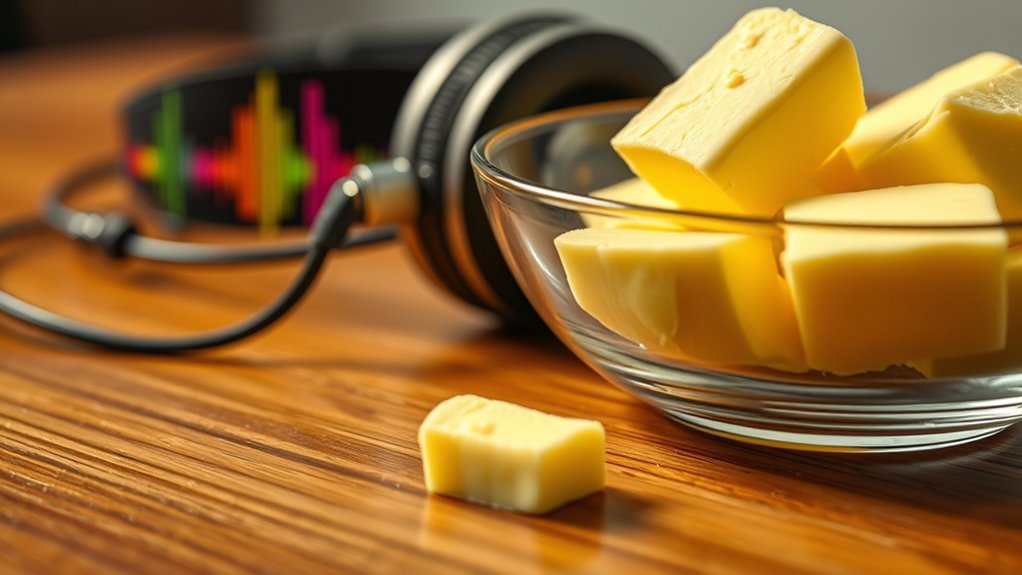
Researchers have conducted experiments to determine how auditory cues influence the perception of butter flavor. These studies reveal a sensory synergy where sound can enhance or diminish flavor experiences, demonstrating flavor modulation through specific auditory stimuli. In one experiment, participants tasted butter while listening to different soundtracks; results showed that high-pitched sounds increased perceived creaminess, while deep tones emphasized richness. Such findings suggest that sound doesn’t just accompany taste but actively shapes flavor perception. These experiments aim to uncover how auditory cues interact with taste receptors, providing insights into multisensory integration. By exploring this relationship, researchers are paving the way for innovative food experiences, where sound design could enhance or alter flavors, creating more immersive and tailored sensory experiences. Additionally, understanding how sound influences perception can lead to practical applications in food presentation and marketing.
Psychological Factors at Play
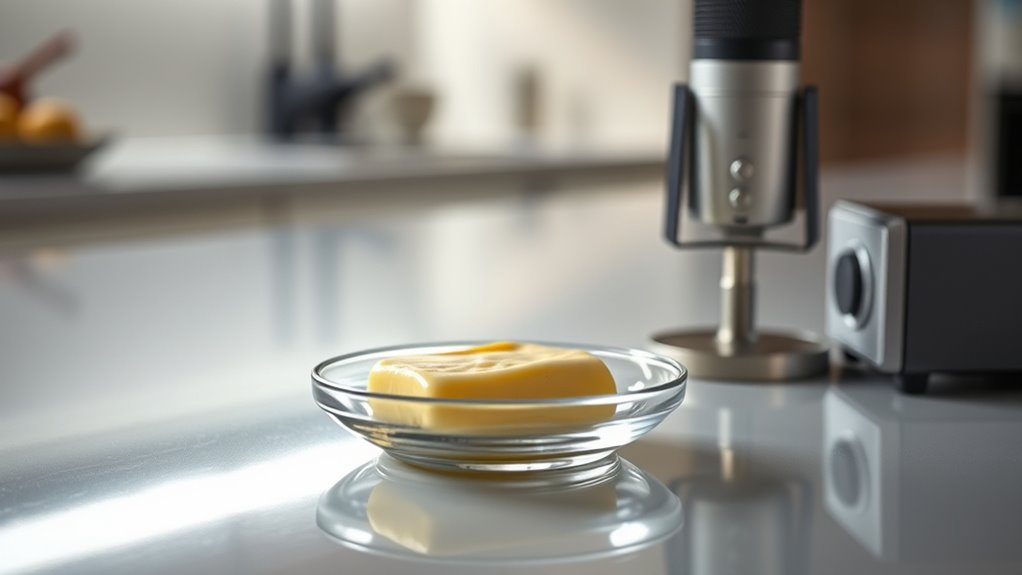
Our perceptions of flavor are deeply influenced by psychological factors that extend beyond the immediate sensory input. Multisensory integration plays a key role, as your brain combines auditory cues with taste and smell, shaping your overall experience. For example, certain sounds can enhance or diminish perceived butter richness, depending on your expectations. Sensory adaptation also affects perception; if you’ve been exposed to a particular sound or flavor repeatedly, your sensitivity may decrease, altering your response over time. These psychological factors can create biases, making you perceive flavors differently based on context or prior experiences. Understanding this interplay helps explain why sound can influence flavor perception—your mind actively interprets multisensory information, sometimes even overriding the actual sensory input. Additionally, techniques from home improvement like soundproofing or acoustic modifications can influence sensory environments, subtly impacting perception in various settings.
Debates and Skepticism in the Field
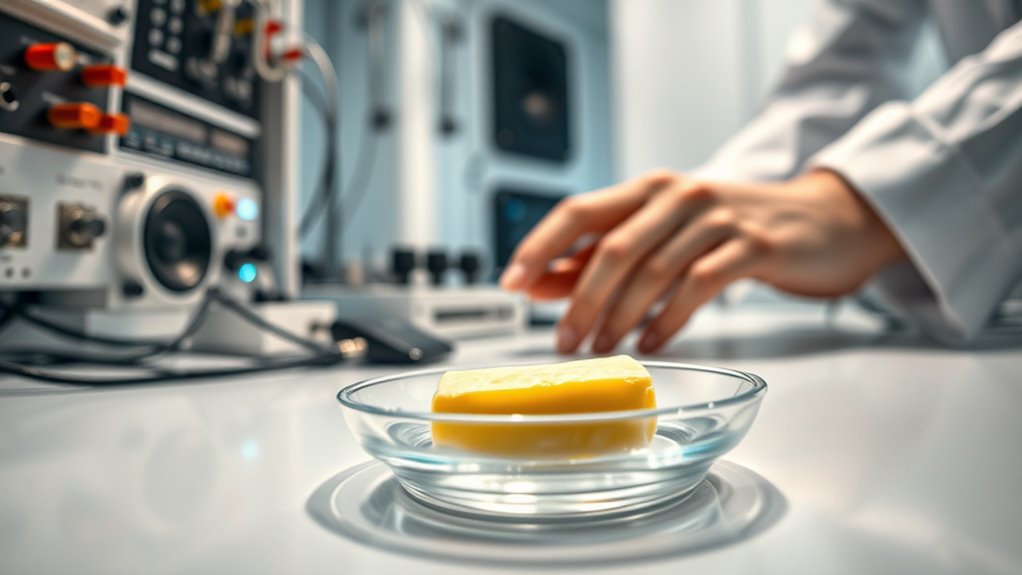
Is the idea that sound can influence flavor perception genuinely supported by solid scientific evidence, or is it more of a sensory illusion? Skeptics argue that many studies overlook factors like sensory adaptation, which can dampen or enhance perceptions over time, making results appear inconsistent. Additionally, cultural biases shape how we interpret sounds and flavors, complicating the science. Some researchers believe that these influences cast doubt on claims that specific sounds directly alter butter flavor perception. Critics also question whether the effects are meaningful or just psychological tricks. The field remains divided: while some experiments show promising links, others highlight the need for more rigorous, controlled research to rule out confounding variables like sensory adaptation and cultural influences. Furthermore, sound-induced flavor changes might be overstated if experimental conditions do not closely mimic real-world eating experiences.
Practical Implications and Future Possibilities

Despite ongoing debates about the scientific validity of sonic seasoning, its potential applications in real-world settings are becoming increasingly intriguing. You could use sound to enhance sensory marketing, creating immersive experiences that influence taste perceptions and boost product appeal. In culinary innovation, chefs and food brands might experiment with tailored soundscapes to elevate flavors, making dishes more memorable or aligning them with brand identities. Sound-driven flavor modulation offers a new dimension in food presentation, encouraging consumers to engage more deeply with their eating experience. As research advances, you’ll find opportunities to develop targeted audio strategies that optimize flavor perception, improve customer satisfaction, and differentiate your offerings. Additionally, understanding how skin hydration impacts the effectiveness of sensory enhancements could lead to more refined and immersive culinary experiences. Sonic seasoning is poised to reshape how we approach food design, blending sound and taste in innovative, impactful ways.
Frequently Asked Questions
Can Sonic Seasoning Be Used to Enhance Other Flavors Besides Butter?
You wonder if sonic seasoning can boost flavors beyond butter. By using music pairing, you can influence how your taste buds perceive various flavors, enabling flavor enhancement across different foods. For example, certain sounds or melodies might make citrus taste brighter or chocolate richer. Experimenting with soundscapes could open new culinary experiences, allowing you to tailor flavor perceptions through carefully chosen audio cues, not just for butter but for a wide range of tastes.
Are There Specific Sounds That Universally Increase Butter Flavor Perception?
Sound sensations can subtly shape your senses, but specific sounds that universally boost butter flavor perception aren’t guaranteed. You might find higher sound frequencies or melodies that evoke positive emotional responses enhance the buttery experience. However, individual preferences vary, so what works for one person may not work for all. Experiment with different sounds, and see how your emotional response influences your perception of butter’s buttery brilliance.
How Long Does the Effect of Sound on Taste Perception Last?
You wonder how long sound influences your taste perception. The effect depends on taste adaptation and sound intensity; as you’re exposed longer, your sensitivity may diminish. Typically, the influence lasts from a few seconds to a minute, but it varies based on how intense the sound is and your individual sensitivity. Keep in mind, prolonged exposure might reduce the impact due to taste adaptation, so the effect isn’t usually permanent.
Do Individual Differences Affect Susceptibility to Sonic Seasoning?
You might find that individual differences, like your taste preferences and sensory sensitivity, influence how much sonic seasoning affects you. People with heightened sensory sensitivity could be more receptive to sound-induced flavor changes, while those with more traditional taste preferences might notice less. Your unique sensory profile plays a role in how sound impacts your perception, making the experience highly personal and varying from person to person.
Could Sonic Seasoning Be Integrated Into Commercial Food Production?
You can see how sonic seasoning might be integrated into commercial food production through sensory marketing and acoustic branding. By designing specific sounds that enhance flavor perception, you could create unique dining experiences or strengthen brand identity. Implementing tailored soundscapes during food presentation or packaging can influence consumer perception and satisfaction, making sonic seasoning a powerful tool for engaging customers and differentiating your products in a competitive market.
Conclusion
Imagine biting into butter and hearing a gentle hum that makes it taste richer, almost like a secret ingredient. While research suggests sound can influence flavor perception, it’s like tuning a radio—sometimes you catch the perfect note, other times it’s just static. As you explore this fascinating world, remember that your senses are more connected than you think. With a little experimentation, you might just discover your own sonic seasoning for everyday delights.


